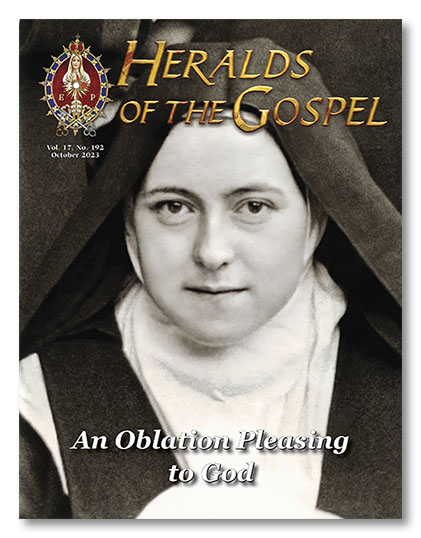Representations of St. Therese of the Child Jesus are often steeped in sentimentality: a languid look, an affected posture and syrupy expressions… However, we only need to look at her photographs, like the one on the cover of this issue, to realize that the holiness of the “little flower of Carmel” had none of the ingenuousness that certain illustrations try to inculcate.
Someone will point out that Therese is the Saint of the “little way”, of humility and unpretentiousness. In fact, according to St. Thomas, pride is the greatest obstacle to holiness and Our Lady was and will only be called blessed because She made herself “the handmaid of the Lord” (Lk 1:38).
Yes, all of this is true, but it is only one aspect of the Theresian triad for achieving holiness. In addition to this, she considered that “to become a saint it was necessary to suffer a lot and always seek the most perfect” (Manuscript A, 10r).
It should be noted at the outset that the little way is quite different from the dark alleys of the pusillanimous. In reality, these cling to trifles while the Theresian proposal consisted in precisely the opposite: to empty oneself so that Christ could occupy one’s soul and raise it up. It was a path that sought to reach the goal – Heaven – as soon as possible, by means of a spiritual “elevator”.
Furthermore, the Saint of Lisieux’s quest for perfection was particularly magnanimous: for her, the “zeal of a Carmelite embraces the whole world” (Manuscript C, 33v) and, inspired by the Apostle, her vocation challenged her to seek ever greater gifts. She repeatedly proclaimed that she wanted to be a “great saint”. That is why she aspired to be a “priest” to carry Christ in her hands, a martyr to give herself entirely to Him, a crusader to fight for His name, a prophet and teacher to enlighten souls with His truth, and a missionary to travel the whole world preaching His Gospel. All this while recognizing that her life would be consummated behind the grille of a cloister…
In short, Therese desired to do for Christ everything that a saint can do. Without timidity, she begged Jesus for “EVERYTHING, EVERYTHING, EVERYTHING,” as she wrote so fervently in a letter to her sister Celine.
It should also be noted that the “suffer a lot” to achieve holiness is an aspect often omitted in pusillanimous circles. As Dr. Plinio Corrêa de Oliveira once pointed out, many are willing to work; some are willing to pray; but no one wants to suffer… Thus, inspired with the love of an expiatory victim, Therese refutes mediocre concepts of holiness: “Holiness does not consist in saying beautiful things, it does not even consist in thinking them, in feeling them!… it consists in suffering and in suffering everything.” (Letter 89, 2v). In the same missive to Celine, she adds: “Holiness! It must be conquered at the point of the sword, you have to suffer… you have to agonize!”
At death’s door, the point of Therese’s sword did not undertake the crusade of St. Joan of Arc, whose life inspired her so much. Instead, she was given an infirmary bed; instead of a standard, the crucifix she firmly held. Had her mission been obliterated?
Of course not. She taught us that what matters is not what you do, but how you do it. A little way trodden with true love of holocaust always becomes sublime in God’s eyes. Therese, because she was authentically little, was also, in the words of St. Pius X, “the greatest Saint of modern times.” ◊




St. Therese I LOVE YOU. thank you for leading me to my medal of you that I lost a week ago. Sister please will you pray for all my family members past present and future generations and the healing of their hearts, including my own, and the salvation of their souls. for I wish them eternity in Heaven with Jesus and Blessed Mother Mary, Amen